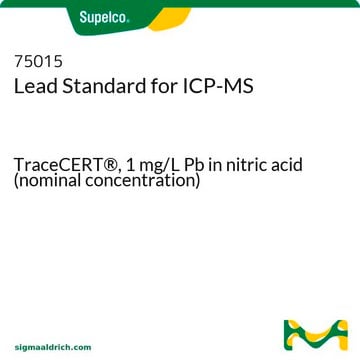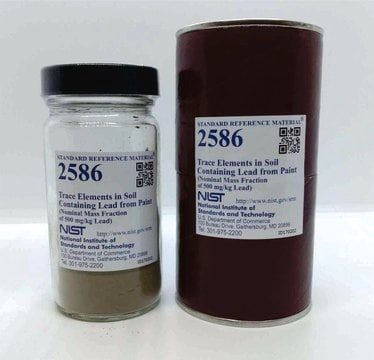All Photos(1)
About This Item
Linear Formula:
PbCrO4
CAS Number:
Molecular Weight:
323.19
EC Number:
MDL number:
UNSPSC Code:
12352300
Recommended Products
grade
ACS reagent
Assay
≥98.0%
impurities
≤0.01% C compounds
≤0.15% solubles
SMILES string
[PbH2++].[O-][Cr]([O-])(=O)=O
InChI
1S/Cr.4O.Pb/q;;;2*-1;+2
InChI key
MOUPNEIJQCETIW-UHFFFAOYSA-N
Looking for similar products? Visit Product Comparison Guide
Signal Word
Danger
Hazard Statements
Precautionary Statements
Hazard Classifications
Aquatic Acute 1 - Aquatic Chronic 2 - Carc. 1A - Repr. 1A - STOT RE 2
Storage Class Code
6.1D - Non-combustible acute toxic Cat.3 / toxic hazardous materials or hazardous materials causing chronic effects
WGK
WGK 3
Flash Point(F)
Not applicable
Flash Point(C)
Not applicable
Personal Protective Equipment
dust mask type N95 (US), Eyeshields, Gloves
Choose from one of the most recent versions:
Already Own This Product?
Find documentation for the products that you have recently purchased in the Document Library.
Eric Camyre et al.
Toxicological sciences : an official journal of the Society of Toxicology, 97(2), 348-354 (2007-03-16)
Particulate hexavalent chromium ((Cr(VI)) compounds are human lung carcinogens. These compounds induce DNA damage, chromosome aberrations, and concentration-dependent cell death in human and Chinese hamster ovary (CHO) cells. The relationship between Cr(VI)-induced DNA damage and chromosome aberrations is poorly understood.
John Pierce Wise et al.
Mutation research, 517(1-2), 221-229 (2002-05-30)
Hexavalent chromium (Cr(VI)) is a human lung carcinogen. Cr(VI) is a particularly important and dangerous carcinogen, because there is widespread exposure to it both occupationally and to the general public. However, despite the potential for widespread exposure and the fact
X I Gu et al.
Osteoarthritis and cartilage, 20(9), 1011-1019 (2012-05-23)
Recent developments on high resolution micro computed tomography (μCT) allow imaging of soft tissues in small animal joints. Nevertheless, μCT images cannot distinguish soft tissues from synovial fluid due to their similar mass density, limiting the 3D assessment of soft
M Oujja et al.
Spectrochimica acta. Part A, Molecular and biomolecular spectroscopy, 102, 7-14 (2012-12-04)
In this study, the reaction of widely used artist's pigments in raw form to pulsed laser radiation of different wavelengths and pulse duration was investigated. Vermilion, lead chromate and malachite (in the form of pellets) were irradiated using laser pulses
Eliza Grlickova-Duzevik et al.
Toxicological sciences : an official journal of the Society of Toxicology, 92(2), 409-415 (2006-05-23)
Water-insoluble hexavalent chromium compounds are well-established human lung carcinogens. Lead chromate, a model insoluble Cr(VI) compound, induces DNA damage, chromosome aberrations, and dose-dependent cell death in human and Chinese hamster ovary (CHO) cells. The relationship between lead chromate-induced DNA damage
Our team of scientists has experience in all areas of research including Life Science, Material Science, Chemical Synthesis, Chromatography, Analytical and many others.
Contact Technical Service










